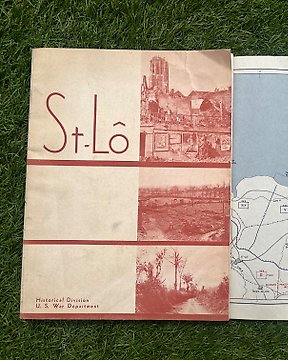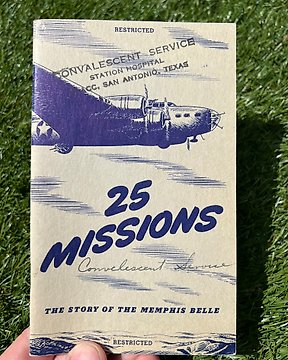Verenigde Staten van Amerika - Nice Official US WW2 Army / Airforce Luftwaffe / Italian / RAF / - Aircraft Recognition Manual - Messerschmitt - Stuka - Spitfire - FW190 - B-17 - B-24 - Mustang - 1943
No. 85060789

Official WW2 US Army Combat Report of the 79th Infantry Division - Named - Invasion of Normandy - Normandy, Northern France, Rhineland, Ardennes, Central Europe - 1945
No. 85060789

Official WW2 US Army Combat Report of the 79th Infantry Division - Named - Invasion of Normandy - Normandy, Northern France, Rhineland, Ardennes, Central Europe - 1945
Up for auction is a very nice and difficult to find, 1945 published, combat history report of the famous 79th Infantry division, which is known for its combat in Normandy, Belgium, Northern France and the Rhineland. It is nicely named and dated on thr cover ''may 1945'' and the name of the veteran. It details all the major combat events of this unit in WW2. It is in good condition for its age, clearly issued, and 100% original.
Nice official and rare USA Army Combat Report of a famous infantry division that will be a great piece for your WW2 collection!
See also our other interesting WW2 items that we offer for auction on catawiki!
History of the 79th Infantry division
Before Organized Reserve infantry divisions were ordered into active military service, they were reorganized on paper as "triangular" divisions under the 1940 tables of organization. The headquarters companies of the two infantry brigades were consolidated into the division's cavalry reconnaissance troop, and one infantry regiment was removed by inactivation. The field artillery brigade headquarters and headquarters battery became the headquarters and headquarters battery of the division artillery. Its three field artillery regiments were reorganized into four battalions; one battalion was taken from each of the two 75 mm gun regiments to form two 105 mm howitzer battalions, the brigade's ammunition train was reorganized as the third 105 mm howitzer battalion, and the 155 mm howitzer battalion was formed from the 155 mm howitzer regiment. The engineer, medical, and quartermaster regiments were reorganized into battalions. In 1942, divisional quartermaster battalions were split into ordnance light maintenance companies and quartermaster companies, and the division's headquarters and military police company, which had previously been a combined unit, was split.[3]
The 79th Infantry Division was ordered into active military service at Camp Pickett, Virginia on 15 June 1942. After basic training, it participated in exercises in the Tennessee Maneuver Area, after which it moved to Camp Laguna near Yuma, Arizona, where it trained in the desert. It was then ordered to Camp Phillips, Kansas for training in winter conditions. At the beginning of April 1944, the division reported to the port of embarkation at Camp Myles Standish, Massachusetts.
"Through France; 14 Jun - 29 Aug 1944" poster 1 of 4 of battle movements of the 79th Infantry Division.
The division arrived in Liverpool on 17 April and began training in amphibious operations. After training in the United Kingdom from 17 April 1944, the 79th Infantry Division landed on Utah Beach, Normandy, 12–14 June and entered combat 19 June 1944, with an attack on the high ground west and northwest of Valognes and high ground south of Cherbourg Naval Base. The division took Fort du Roule after a heavy engagement and entered Cherbourg, 25 June. It was around this time that Corporal John D. Kelly and First Lieutenant Carlos C. Ogden, both of the 314th Infantry Regiment, were awarded the Medal of Honor.[4] It held a defensive line at the Ollonde River until 2 July 1944 and then returned to the offensive, taking La Haye du Puits in house-to-house fighting, 8 July. On 26 July, the 79th attacked across the Ay River, took Lessay, crossed the Sarthe River and entered Le Mans, 8 August, meeting only light resistance. The advance continued across the Seine, 19 August. Heavy German counterattacks were repelled, 22–27 August, and the division reached the Therain River, 31 August. Moving swiftly to the Franco-Belgian frontier near St. Amand (east of Lille), the division was then moved to XV Corps in eastern France, where it encountered heavy resistance in taking Charmes in street fighting, 12 September. The 79th cut across the Moselle and Meurthe Rivers, 13–23 September, cleared the Forêt de Parroy in a severe engagement, 28 September – 9 October, and attacked to gain high ground east of Emberménil, 14–23 October, when it was relieved, 24 October.
After rest and training at Lunéville, the division returned to combat with an attack from the MignevineMontiguy area, 13 November 1944, which carried it across the Vezouse and Moder Rivers, 18 November – 10 December, through Haguenau in spite of determined enemy resistance, and into the Siegfried Line, 17–20 December. The division held a defensive line along the Lauter River, at Wissembourg from 20 December 1944 until 2 January 1945, when it withdrew to Maginot Line defenses. The German attempt to establish a bridgehead west of the Rhine at Gambsheim resulted in furious fighting. The 79th beat off German attacks at Hatten and Rittershoffen in an 11-day battle before withdrawing to new defensive positions south of Haguenau on the Moder River, 19 January 1945. The division remained on the defensive along the Moder until 6 February 1945. During February and March 1945, the division mopped up German resistance, returned to offensive combat, 24 March 1945, crossed the Rhine, drove across the Rhine-Herne Canal, 7 April, secured the north bank of the Ruhr and took part in clearing the Ruhr Pocket until 13 April. The division then went on occupation duty, in the Dortmund, Sudetenland, and Bavarian areas successively, until its return to the United States and inactivation.
You might also like
- 16+
This object was featured in
How to buy on Catawiki
1. Discover something special
2. Place the top bid
3. Make a secure payment







